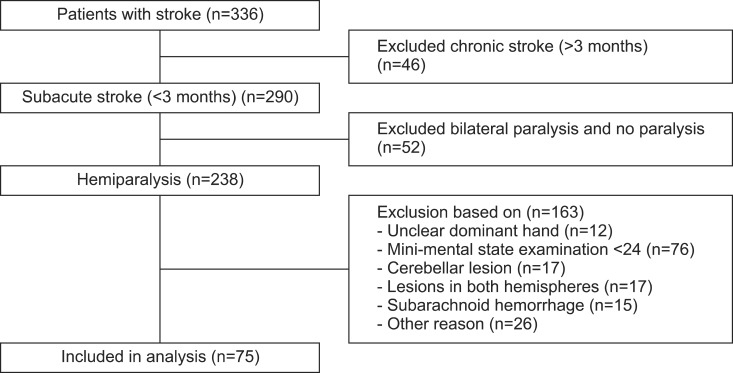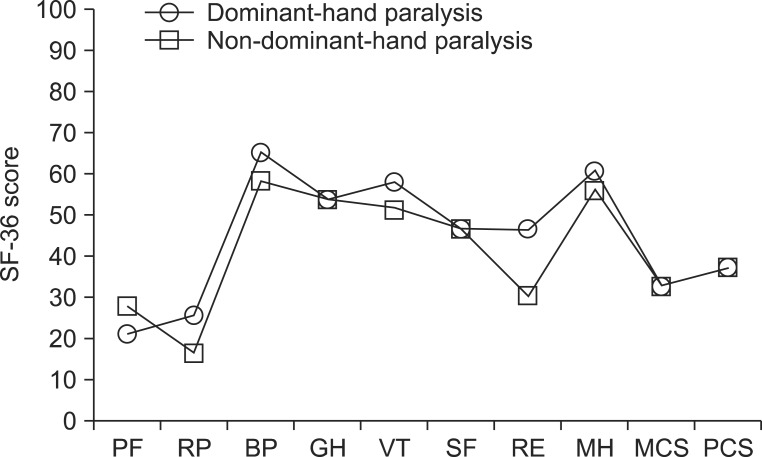Ann Rehabil Med.
2014 Aug;38(4):450-457. 10.5535/arm.2014.38.4.450.
Effect of Dominant Hand Paralysis on Quality of Life in Patients With Subacute Stroke
- Affiliations
-
- 1Department of Rehabilitation Medicine, Kyungpook National University College of Medicine, Daegu, Korea. teeed0522@hanmail.net
- 2Department of Rehabilitation Medicine, Kyungpook National University Hospital, Daegu, Korea.
- KMID: 2165727
- DOI: http://doi.org/10.5535/arm.2014.38.4.450
Abstract
OBJECTIVE
To evaluate the degree to which the paralysis of a dominant hand affects quality of life (QOL) in patients with subacute stroke.
METHODS
We recruited 75 patients with subacute hemiplegic stroke. Patients were divided into two groups according to the location of the lesion and the side of the dominant hand. Group 1 consisted of patients whose strokes affected the dominant hand (i.e., right hemiplegia and right dominant hand or left hemiplegia and left dominant hand). Group 2 consisted of patients whose strokes affected the non-dominant hand (i.e., left hemiplegia and right dominant hand or right hemiplegia and left dominant hand). The primary outcome measure was the Short-Form 36-Item Health Survey (SF-36), which was used to evaluate health-related QOL. Secondary outcomes were scores on the Modified Barthel Index (MBI) and Beck Depression Inventory (BDI).
RESULTS
We did not find any statistically significant differences between the groups in any SF-36 domain including the summaries of physical and mental component. Similarly, the MBI and BDI scores were not significantly different between the groups.
CONCLUSION
The effect of paralysis on the dominant hand and QOL in patients with subacute stroke was not significantly different from the effect of paralysis on the non-dominant hand.
Keyword
MeSH Terms
Figure
Cited by 1 articles
-
Comparison of Functions, Activity of Daily Living, and Quality of Life according to Hand Dominance in Stroke
Minsu Park, Eun Joo Kim, Junhee Han, Myung Hoon Moon, Yun-Hee Kim, Sung-Hwa Ko, Yong-Il Shin
Brain Neurorehabil. 2015;8(2):96-103. doi: 10.12786/bn.2015.8.2.96.
Reference
-
1. Han B, Haley WE. Family caregiving for patients with stroke: review and analysis. Stroke. 1999; 30:1478–1485. PMID: 10390326.2. Jonsson AC, Lindgren I, Hallstrom B, Norrving B, Lindgren A. Determinants of quality of life in stroke survivors and their informal caregivers. Stroke. 2005; 36:803–808. PMID: 15761203.
Article3. Black-Schaffer RM, Osberg JS. Return to work after stroke: development of a predictive model. Arch Phys Med Rehabil. 1990; 71:285–290. PMID: 2327878.4. Pyun SB, Kim SH, Hahn MS, Kwon HK, Lee HJ. Quality of life after stroke. J Korean Acad Rehabil Med. 1999; 23:233–239.5. Triggs WJ, Calvanio R, Levine M, Heaton RK, Heilman KM. Predicting hand preference with performance on motor tasks. Cortex. 2000; 36:679–689. PMID: 11195914.
Article6. Provins KA. The specificity of motor skill and manual asymmetry: a review of the evidence and its implications. J Mot Behav. 1997; 29:183–192. PMID: 12453794.
Article7. Harris JE, Eng JJ. Individuals with the dominant hand affected following stroke demonstrate less impairment than those with the nondominant hand affected. Neurorehabil Neural Repair. 2006; 20:380–389. PMID: 16885424.
Article9. Bestelmeyer PE, Carey DP. Processing biases towards the preferred hand: valid and invalid cueing of left- versus right-hand movements. Neuropsychologia. 2004; 42:1162–1167. PMID: 15178168.
Article10. Kauranen K, Vanharanta H. Influences of aging, gender, and handedness on motor performance of upper and lower extremities. Percept Mot Skills. 1996; 82:515–525. PMID: 8724924.
Article11. Gowland C, deBruin H, Basmajian JV, Plews N, Burcea I. Agonist and antagonist activity during voluntary upper-limb movement in patients with stroke. Phys Ther. 1992; 72:624–633. PMID: 1508970.
Article12. Spaulding SJ, McPherson JJ, Strachota E, Kuphal M, Ramponi M. Jebsen Hand Function Test: performance of the uninvolved hand in hemiplegia and of right-handed, right and left hemiplegic persons. Arch Phys Med Rehabil. 1988; 69:419–422. PMID: 3377667.13. Laufer Y, Gattenio L, Parnas E, Sinai D, Sorek Y, Dickstein R. Time-related changes in motor performance of the upper extremity ipsilateral to the side of the lesion in stroke survivors. Neurorehabil Neural Repair. 2001; 15:167–172. PMID: 11944737.
Article14. De Haan RJ, Limburg M, Van der Meulen JH, Jacobs HM, Aaronson NK. Quality of life after stroke: impact of stroke type and lesion location. Stroke. 1995; 26:402–408. PMID: 7886714.15. McMeekan ER, Lishman WA. Retest reliabilities and interrelationship of the Annett hand preference questionnaire and the Edinburgh Handedness Inventory. Br J Psychol. 1975; 66:53–59.
Article16. Han CW, Lee EJ, Iwaya T, Kataoka H, Kohzuki M. Development of the Korean version of Short-Form 36-Item Health Survey: health related QOL of healthy elderly people and elderly patients in Korea. Tohoku J Exp Med. 2004; 203:189–194. PMID: 15240928.
Article17. Ware JE Jr. SF-36 health survey update. Spine (Phila Pa 1976). 2000; 25:3130–3139. PMID: 11124729.
Article18. Goulding MR, Rogers ME, Smith SM. Public health and aging: trends in aging: United States and worldwide. JAMA. 2003; 289:1371–1373. PMID: 12636453.19. Jung HY, Park BK, Shin HS, Kang YK, Pyun SB, Paik NJ, et al. Development of the Korean version of Modified Barthel Index (K-MBI): multi-center study for subjects with stroke. J Korean Acad Rehabil Med. 2007; 31:283–297.20. Kim WH, Hahn SJ, Im HJ, Yang KS. Reliability and validity of the Korean World Health Organization Quality of Life (WHOQOL)-BREF in people with physical impairments. Ann Rehabil Med. 2013; 37:488–497. PMID: 24020029.
Article21. Jang SH, Rah UW, Kim YC, Park YS, Jo D, Kim YC, et al. Development of Korean Academy of Medical Sciences guideline-rating the impairment in pain. J Korean Med Sci. 2009; 24(Suppl 2):S330–S337. PMID: 19503691.
Article22. Kim HJ, Park EH. Diagnostic efficiency of BDI in a clinical setting: comparison among depression, anxiety, psychosis and control group. Int J Innov Managd Technol. 2010; 1:502–506.23. Hahn HM, Yum TH, Shin YW, Kim KH, Yoon DJ, Chung KJ. A standardization study of Beck Depression Inventory in Korea. J Korean Neuropsychiatr Assoc. 1986; 25:487–500.24. Beck AT. Psychometric properties of the Beck Depression Inventory: twenty-five years of evaluation. Clin Psychol Rev. 1988; 8:77–100.
Article25. Perry S, Kowalski TL, Chang CH. Quality of life assessment in women with breast cancer: benefits, acceptability and utilization. Health Qual Life Outcomes. 2007; 5:24. PMID: 17474993.
Article26. Donaldson MS. Taking stock of health-related quality-of-life measurement in oncology practice in the United States. J Natl Cancer Inst Monogr. 2004; (33):155–167. PMID: 15504926.
Article27. Wang HM, Beyer M, Gensichen J, Gerlach FM. Healthrelated quality of life among general practice patients with differing chronic diseases in Germany: cross sectional survey. BMC Public Health. 2008; 8:246. PMID: 18638419.
Article28. Coons SJ, Rao S, Keininger DL, Hays RD. A comparative review of generic quality-of-life instruments. Pharmacoeconomics. 2000; 17:13–35. PMID: 10747763.
Article30. Doan QV, Brashear A, Gillard PJ, Varon SF, Vandenburgh AM, Turkel CC, et al. Relationship between disability and health-related quality of life and caregiver burden in patients with upper limb poststroke spasticity. PM R. 2012; 4:4–10. PMID: 22200567.
Article31. Han TR, Yoon KJ, Jung SH. The chronological review of uninvolved hand function in stroke patients. J Korean Acad Rehabil Med. 2004; 28:13–19.32. Hadidi N, Treat-Jacobson DJ, Lindquist R. Poststroke depression and functional outcome: a critical review of literature. Heart Lung. 2009; 38:151–162. PMID: 19254633.
Article
- Full Text Links
- Actions
-
Cited
- CITED
-
- Close
- Share
- Similar articles
-
- Importance of Lesion Laterality in Hand Function Rehabilitation in Stroke Patients
- Comparison of Functions, Activity of Daily Living, and Quality of Life according to Hand Dominance in Stroke
- The Effect of Prolonged Inpatient Rehabilitation Therapy in Subacute Stroke Patients
- Effect of Decreased Skeletal Muscle Index and Hand Grip Strength on Functional Recovery in Subacute Ambulatory Stroke Patients
- Relationship Between Grip and Pinch Strength and Activities of Daily Living in Stroke Patients



